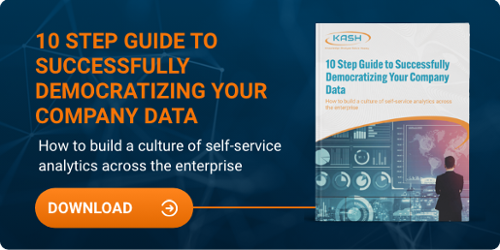Strategies to Make Your Business Analytics Easy to Access, Reliable & Accurate
Topic:
Democratizing Data
Data and analytics are often used interchangeably, and it's important to define them separately.
Analytics is assembling and presenting disparate data into a consumable format or information. Data, however, is not analytics. Data is a set of facts, such as:
- Location
- Date
- Time
- Color
- Size
These are all facts and data points. Without data analytics, however, there's little context. For example, you can know from data that something is six feet long but never know it's a boa constrictor. On the other hand, when you can determine the snake is under your chair, it significantly changes your response.
Data analytics is the assembly and presentation of disparate data into a consumable format and delivered promptly to the appropriate person to support effective decision-making.
Your organization receives and processes vast amounts of data daily, but a piece of that data alone is of no value to the organization until it is assembled and presented to the right person. For example, telling the CEO that the temperature of a cold storage locker is 68 degrees may be a fact, but telling the Cold Storage Manager this same fact becomes actionable information to support his decision-making.
The key is tailoring information to the audience.
Making business analytics more accessible for business users requires a shift in mindset from thinking about the data to thinking about the data use and the end user. This requires understanding the use cases for data analysis. From there, you can work backward to determine the data needed and the governance policies to support the use cases.
Why Should Business Analytics be Easily Accessible?
Information is the lifeblood of any organization. Without information, an organization can stagnate. With bad data or stale data, it can make poor or ineffective decisions.
When you have clean and accurate data for business analytics and provide the correct data to the right people, it can be a powerful tool. Data accessibility allows you to:
- Make better, data-driven decisions
- Make faster, more agile decisions
- Reduce the time for insight and time to market
- Create a data-centric culture within an organization
Developing a Business Analytics Strategy
So, where do businesses begin when developing a business analytics strategy?
At the beginning, of course!
First, the organization needs an effective data management strategy, from ingestion to transformation to storage and finally consumption. This strategy must include policies and procedures that ensure the accuracy and security of the data assets of the organization, as well as any regulatory compliance requirements.
Within the strategy, the organization must also define the data management processes with an emphasis on democratizing data to empower their end users and frontline decision-makers.
To support the data management strategy, organizations must also clearly communicate the governance policies and define the guardrails that apply to various users throughout the organization. While you want to provide data to frontline employees, you also want to protect your data by requiring authentication and authorization for use.
Finally, the strategy should also include a plan to improve and enhance data literacy throughout the organization to successfully complete the transformation to a broad data-driven culture.
User-Friendly Tools Enable Buy-In
As part of empowering users, organizations need user-friendly tools that make it easy to build custom applications for analysis.
While sophisticated business intelligence applications may require development, low-code and no-code tools allow executives and frontline employees to create dashboards and data visualizations. This makes it easy for users, at all levels to:
- Access data relevant to their role and security level
- Provide for the development of targeted analytics
- Distribute these analytics to required users
- Collaborate on decision-making.
The use of these application sets should require minimal training. For example, data visualization makes it easy for anyone viewing it to understand the key metrics and recognize anomalies.
It is also crucial that businesses develop and implement a data literacy program throughout the entire organization. This program should focus on developing intimacy between your staff and the data they interact with daily. The more comfortable your team is with the data, the more readily they can assemble and present data as information.
Developing a data-driven organization takes work. 92% of executives say cultural obstacles are the biggest barrier to widespread adoption. This is why barely more than a quarter of companies say they are truly data-driven organizations.
Why Is Access to Information So Important?
Depending on the type of business you are in, there are plenty of reasons for providing easy, seamless, and timely access to information across your business, including:
- Empowering leaders and decision-makers with the information they need
- Improving customer service and support
- Building trust
- Increasing employee satisfaction
- Creating a competitive advantage
A study by Bain & Company reported that companies that had the most-developed analytics capabilities had significantly larger market shares than their competitors. In fact, companies with a data-driven culture were twice as likely to be among their industry's top quartile for profitability.
You may have more specific reasons within your organization that require easy data access. Aligning your data analytics with your business goals is crucial to creating a strategy for business success. Combined with the proper technologies, this data strategy will unlock the full potential of your organization.
What is a Data Silo & How to Avoid Them
A data silo exists when data is only accessible by certain people or departments. For example, customer data may be stored in a Customer Relationship Management (CRM) platform for sales and marketing but inaccessible to customer support teams. This prevents support teams from accessing the wealth of data that exists within a company about customers, which may help provide a better overall customer experience.
Not only can it prevent people from accessing data, but it can also skew data analytics. If one department doesn't have access to all the data, they can easily make faulty decisions because they don't see the whole picture. Data silos slow the pace of your organization, create security risks, waste storage space, and threaten the accuracy of your data analysis.
Nearly every business struggles with multiple data silos. This can create expensive and time-consuming problems for your business, but they are relatively simple to resolve with a proper understanding of the reasons these silos exist and a commitment to eliminating them.
Eliminating these issues with a solid user-focused data strategy that significantly enhances access to data removes the need for establishing and maintaining silos.
Building a Data-Centric Culture
Creating easier access to the information your teams need to make solid business decisions is crucial to building a data-centric culture for success. It requires a focused approach to understanding the as-is state of your data, defining the to-be state, and building a roadmap that allows you to navigate from as-is to to-be.
Part of that roadmap must include the necessary training to make your organization data literate. Gartner says that over half of all businesses do not have sufficient data literacy to properly leverage their data and information assets, yet data literacy is essential in driving business value.
Without data literacy, you will significantly limit your ability to gain valuable insights even if you achieve organization-wide data access.
Learn how to develop a business intelligence strategy that's easy to access, reliable, and accurate by first democratizing your company data. Download the eBook to learn more, “A 10-Step Guide to Successfully Democratizing Your Company Data.”
